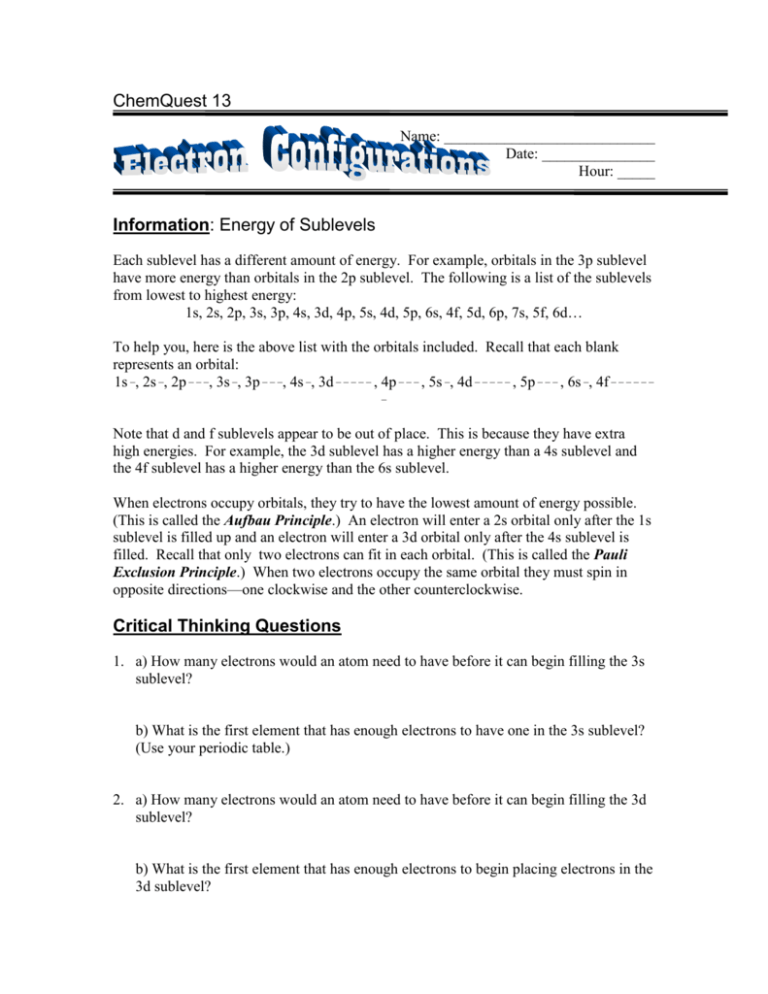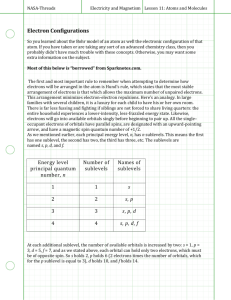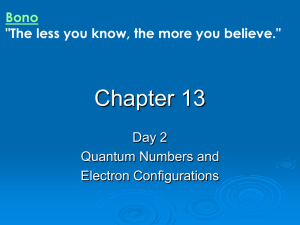ChemQuest 13_configurations
advertisement

ChemQuest 13 Name: ____________________________ Date: _______________ Hour: _____ Information: Energy of Sublevels Each sublevel has a different amount of energy. For example, orbitals in the 3p sublevel have more energy than orbitals in the 2p sublevel. The following is a list of the sublevels from lowest to highest energy: 1s, 2s, 2p, 3s, 3p, 4s, 3d, 4p, 5s, 4d, 5p, 6s, 4f, 5d, 6p, 7s, 5f, 6d… To help you, here is the above list with the orbitals included. Recall that each blank represents an orbital: 1s _, 2s _, 2p _ _ _, 3s _, 3p _ _ _, 4s _, 3d _ _ _ _ _ , 4p _ _ _ , 5s _, 4d _ _ _ _ _ , 5p _ _ _ , 6s _, 4f _ _ _ _ _ _ _ Note that d and f sublevels appear to be out of place. This is because they have extra high energies. For example, the 3d sublevel has a higher energy than a 4s sublevel and the 4f sublevel has a higher energy than the 6s sublevel. When electrons occupy orbitals, they try to have the lowest amount of energy possible. (This is called the Aufbau Principle.) An electron will enter a 2s orbital only after the 1s sublevel is filled up and an electron will enter a 3d orbital only after the 4s sublevel is filled. Recall that only two electrons can fit in each orbital. (This is called the Pauli Exclusion Principle.) When two electrons occupy the same orbital they must spin in opposite directions—one clockwise and the other counterclockwise. Critical Thinking Questions 1. a) How many electrons would an atom need to have before it can begin filling the 3s sublevel? b) What is the first element that has enough electrons to have one in the 3s sublevel? (Use your periodic table.) 2. a) How many electrons would an atom need to have before it can begin filling the 3d sublevel? b) What is the first element that has enough electrons to begin placing electrons in the 3d sublevel? Information: Hund’s Rule Electrons can be “paired” or “unpaired”. Paired electrons share an orbital with their spins parallel. Unpaired electrons are by themselves. For example, boron has one unpaired electron. Boron’s orbital diagram is below: If we added one more electron to boron’s orbital diagram we will get carbon’s orbital diagram. One important question is: where does the next electron go? The electron has a choice between two equal orbitals—which of the 2p orbitals will it go in? Hund’s rule tells us which of the above choices is correct. Hund’s rule states: when electrons have a choice of entering two equal orbitals they enter the orbitals so that a maximum number of unpaired electrons result. Also, the electrons will have parallel spins. Therefore Choice A is carbon’s actual orbital diagram because the p electrons are in separate orbitals and they have parallel spins! The following are the electron orbital diagrams for the next elements, nitrogen and oxygen. Notice that nitrogen’s 2p electrons are all unpaired to obey Hund’s Rule. The 2p electrons are forced to begin pairing up in oxygen’s configuration. Critical Thinking Questions 3. How many “unpaired” electrons are in a nitrogen atom? 4. Why does carbon’s sixth electron have to go into another p orbital? Why can’t it go into a 2s orbital? Why can’t it go into a 3s orbital? 5. Write the electron orbital diagram for phosphorus. 6. Write the electron orbital diagram for arsenic. 7. Compare the orbital diagrams for nitrogen (see information section above), phosphorus (question 5) and arsenic (question 6). What is similar about the electrons in the last sublevel for each of them? Information: Electron Configurations vs. Orbital Diagrams The electron orbital diagram of an atom can be abbreviated by using what is called electron configurations. The following is the electron configuration for carbon: 1s2 2s2 2p2. The following is the electron configuration for several elements whose orbital diagrams are given above: Carbon: 1s2 2s2 2p2 nitrogen: 1s2 2s2 2p3 oxygen: 1s2 2s2 2p4 Critical Thinking Questions 8. What are the small superscripts (for example, the 4 in oxygen) representing in an electron configuration? 9. What information is lost when using electron configurations instead of orbital diagrams? When might it be more helpful to have an orbital diagram instead of an electron configuration? 10. How many unpaired electrons are in a sulfur atom? What did you need to answer this question—an orbital diagram or an electron configuration? 11. Write the electron configuration for zirconium (atomic # = 40). 12. Write the configuration for argon (atomic # = 18). 13. Write the electron configuration for calcium (atomic # = 20). Notice that calcium has all of argon’s electrons plus two additional ones in a 4s orbital.







